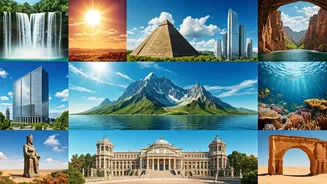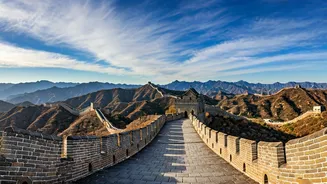Great Wall of China
The Great Wall of China is a symbol of human perseverance and architectural brilliance. Stretching for over 13,000 miles, this ancient fortification winds
its way through diverse terrains, offering a captivating historical narrative. Constructed over centuries, the wall served as a defensive barrier, reflecting China's rich past. Visitors can walk along sections of the wall, experiencing stunning vistas and gaining a deeper understanding of its strategic importance and the labor-intensive construction that took place. Its imposing presence and intricate design stand as a testament to the ingenuity and determination of those who built it, offering a profound appreciation for its historical value and enduring legacy. Its imposing presence and intricate design stand as a testament to the ingenuity and determination of those who built it, offering a profound appreciation for its historical value and enduring legacy.
Petra, Jordan's Gem
Nestled in the Jordanian desert, Petra is a city carved into sandstone cliffs, offering a breathtaking display of ancient Nabataean architecture. The Treasury, Al-Deir (the Monastery), and other remarkable structures tell tales of a civilization that flourished over two millennia ago. Accessible through a narrow gorge called the Siq, Petra reveals its grandeur gradually, heightening the sense of wonder. The intricate facades, meticulously carved into the pink sandstone, showcase a sophisticated understanding of engineering and art. Its remote location and well-preserved structures offer a unique opportunity to journey back in time and witness the skill and artistry of the Nabataeans, making it a place of both historical and artistic significance. The play of light and shadow across the rose-colored cliffs adds to its mystique.
Machu Picchu, Peru
Perched high in the Andes Mountains, Machu Picchu is a stunning testament to the Inca civilization's mastery of architecture and its harmonious connection with the natural world. This ancient citadel, discovered in the early 20th century, showcases intricate stonework and strategic planning, all set against a backdrop of breathtaking mountain scenery. The precision with which the stones are fitted together, without mortar, is a feat of engineering even by today's standards. Visitors can explore temples, residences, and plazas, all the while taking in panoramic views of the surrounding valleys. The site's remote location contributed to its preservation and adds to its mysterious allure, embodying the legacy of the Inca Empire and drawing adventurers and history buffs alike.
The Colosseum, Rome
In the heart of Rome, The Colosseum stands as a striking reminder of the Roman Empire's power and entertainment. This iconic amphitheater once hosted gladiatorial contests, public spectacles, and dramatic performances for the Roman populace. Constructed of stone and concrete, the Colosseum could accommodate tens of thousands of spectators. Its complex network of tunnels and seating arrangements, along with its overall scale, offers a vivid illustration of Roman engineering prowess. Today, the Colosseum, with its imposing facade and rich history, provides insight into the values and lifestyle of ancient Romans, making it a must-see for anyone visiting the Eternal City. Its enduring presence makes it a true symbol of Rome.
Taj Mahal, India
The Taj Mahal, situated in Agra, India, is an architectural marvel and a monument to eternal love. This magnificent mausoleum was commissioned by Mughal Emperor Shah Jahan in memory of his beloved wife, Mumtaz Mahal. Built entirely of white marble, the Taj Mahal is renowned for its intricate craftsmanship, symmetrical design, and exquisite details. It features inlaid gemstones, delicate carvings, and expansive gardens that create a stunning visual experience. The monument's ethereal beauty and poignant history draw visitors from around the world, who come to witness its beauty and reflect on a timeless expression of love. The Taj Mahal is a significant part of India's cultural heritage.
Chichen Itza, Mexico
Chichen Itza, located in the Yucatán Peninsula of Mexico, is an extraordinary example of Mayan civilization. This archaeological site offers a glimpse into the sophisticated culture of the Mayans, including their advanced knowledge of astronomy and architecture. The centerpiece of Chichen Itza is the El Castillo pyramid, which stands as a precise testament to the Mayan calendar. Visitors can explore numerous structures, including temples, observatories, and ball courts, that showcase the Mayans' understanding of mathematics and engineering. The precise alignment of these structures with celestial events highlights their advanced civilization and offers a fascinating peek into their society, rituals, and practices. Visiting Chichen Itza is like walking into the heart of Mayan history.
Christ the Redeemer, Brazil
Perched atop Corcovado Mountain in Rio de Janeiro, Brazil, Christ the Redeemer is an iconic statue that embraces the city with open arms. Completed in 1931, the Art Deco statue is a symbol of faith and a landmark of incredible artistry. The statue provides stunning panoramic views of Rio, from the beaches to the mountains. The sculpture's impressive size and the dedication of the project highlight the city's unique blend of cultural pride. Visitors can access the statue by train, allowing them to traverse through the lush Tijuca Forest. Christ the Redeemer continues to attract people from all around the world and demonstrates Brazil’s heritage and welcoming spirit.
Eiffel Tower, France
The Eiffel Tower, a timeless icon of Paris, represents architectural ingenuity and the spirit of innovation. Constructed for the 1889 World's Fair, the iron lattice tower has become synonymous with the city. Visitors can ascend to multiple levels for stunning views of Paris, from the Champ de Mars to the Seine River. The tower's elegant design, with its detailed construction, serves as a testament to the engineering feats of the late 19th century. Day or night, the Eiffel Tower showcases the allure of Paris, making it an essential destination for every traveler. The lighting at night, along with its unique structure, makes it a true highlight of the city.
Hagia Sophia, Turkey
The Hagia Sophia in Istanbul is a building that has served various purposes through the centuries, reflecting a rich historical past. Initially built as a cathedral, it became a mosque and now functions as a museum. Its massive dome, mosaic decorations, and extensive interior show the influence of Byzantine and Ottoman artistry. The Hagia Sophia serves as a reminder of the cultural exchange and diverse history that has shaped the city. Its architectural mastery, from its vast interior to its complex design, draws in visitors worldwide. The interior with its incredible mosaics adds a beautiful and significant component to the building’s history.











